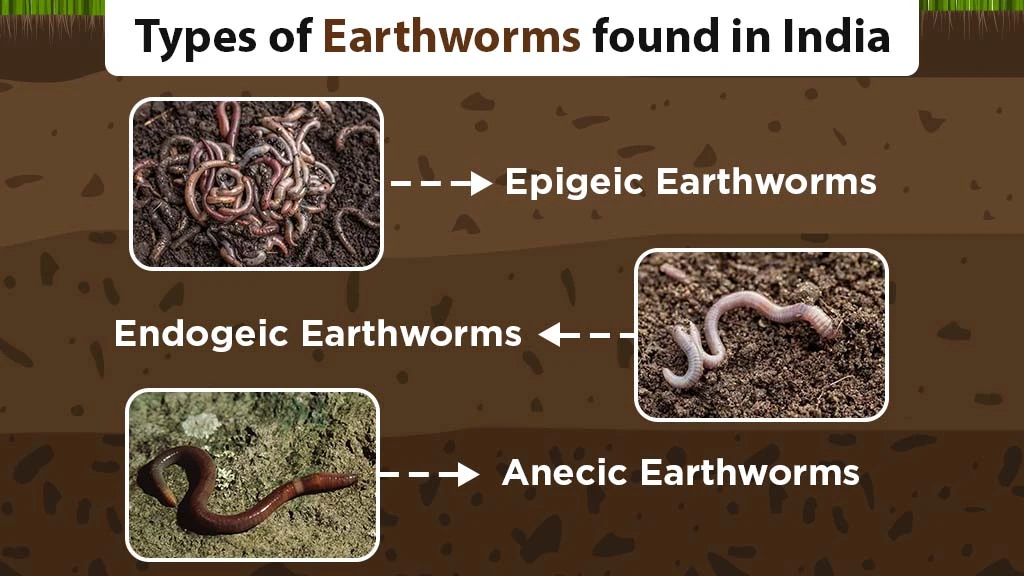Role of Earthworms in Soil Fertility: Importance and Types

Earthworms commonly occur in the soil and their role is quite important in farmers’ lives as they increase water holding capacity and increase soil fertility. They are also known as “farmer’s friend”. This blog explores the role of earthworms in improving soil structure along with their importance, types and factors promoting their population.
Table of Contents
- Introduction
- Types of Earthworms found in India
- Role of Earthworm in improving Soil Health
- How to Promote Earthworm’s Population?
- A Way Forward – Earthworms as a Farmer’s Friend
Introduction
Earthworms live in organic matter rich soil, having long, cylindrically elongated bodies, compressed at both ends, and are covered with a soft, thin pellicle. The scientific name of earthworm is “Lumbricina”. They improve soil aeration, structure, nutrient cycling, infiltration, water movement, and plant growth. Out of 3627 species, 509 species of earthworms are found in India.
Types of Earthworms found in India

Earthworms are majorly divided into two categories, Microdrilli and Megadrilli, based on their ecological adaptations. Further megadrilli are classified into three major types which are discussed below.
Epigeic Earthworms
Epigeic Earthworms live on the upper surface of soil and do not build burrows. They are the surface feeders feed on surface debris, decay organic wastes, leaf litter, plant roots, and animal dung and convert them into vermicast. These are small, around 1 to 18 cm in length. These earthworms are not involved in organic and inorganic matter mixing.
Endogeic Earthworms
Endogeic Earthworms live beneath the topsoil and build horizontal burrows in the soil. They are about 2.5 to 30 cm in length. These earthworms are known to improve soil structure because they feed more soil and less organic matter. Thus, they are generally not good for vermicomposting. Their productivity rate is slower than epigeic earthworms but relatively have good life span than the previous one.
Anecic Earthworms
Anecic Earthworms live in the innermost part of the soil at a depth of 3 meters and build vertical burrows of around 2 centimeters. They mix organic nutrients in the soil and enhance the soil texture. These worms are the longest species category as they are about 3 cm to up to 20 cm long. Anecic earthworms have low decomposition efficacy of organic matter thus they are not suitable for vermicomposting. But they have longer life spans than epigeic and endogeic earthworms.
Role of Earthworm in improving Soil Health
Humification
The breakdown of organic matter into the humus is known as humification. Microbes in the soil form a part of food for earthworms. Microbes are proliferated in the gut and Vermicompost. Earthworms help in the distribution of microbes in the soil. The role of microbes and earthworms in decompositions of organic matter in humification is common. With the increase in microbial population there is an increase in microbial activity and humic acid content.
Nutrient Availability
Earthworms play a major role in the breakdown of organic matter to release nutrients. These consume more organic surface matters than other soil animals jointly. They excrete nutrient rich cast which are water-soluble and are readily available to plants.
Enhancing Soil Nitrogen
The soil nitrogen mineralization and availability are increased by earthworm casting; thus, it increases the nitrogen content in the soil. Nitrogen mineralization increased by earthworm casting either directly or indirectly.
Maintaining Soil Phosphorus
Phosphorus is the second most important nutrient after nitrogen for the plant’s growth. Phosphorus is responsible for energy storage and transfer in the metabolic activities of cells. It helps to stimulate the early vegetative growth thus, early maturity of grain crops.
Control of Soil-borne Pests
The role of earthworms in controlling the soil borne pests is very important as earthworms improve soil fertility and promote beneficial organisms. They eat harmful pests and decrease the concentration of these harmful organisms in soil. Thus, they contribute to the good natural regulation of pests and insects.
How to Promote Earthworm’s Population?
There are certain practices through which earthworms’ population can be promoted. Let’s discuss each below.
- Effective agricultural practices like minimal usage of rotating implements and avoiding intensive tillage operations can promote the growth of earthworms.
- The use of light weight implements reduces soil compaction thus, improving the loss of earthworms. Tillage activity should be done only when the soil is dry or in well-drained soil.
- The inclusion of diversified crop residues by ploughing in the soil increases the earthworm population.
- The right use of fertilizers can promote earthworms’ population. So, it’s better to use slightly rotten compost than the ripen one to increase earthworm’s life. Also, organic residues can be buried at shallow depths so that it cannot harm earthworms at deeper levels in the soil.
A Way Forward – Earthworms as a Farmer’s Friend
Earthworms maintain soil health in many ways such as nutrient management, organic matter breakdown, aeration, good root penetration, soil fertility and crop productivity. To obtain better yield, modern technologies are degrading the ecosystem. For example, the use of chemical fertilizers degrades the soil which results in a decrease in the earthworm population because of the environmental factors.
Proper earthworm management is a necessity to control the loss of earthworms’ population in the country. So, the sufficient use of organic manures instead of chemical fertilizers, avoiding intensive tillage, and using lightweight implements can help enhancing earthworms’ activity in the soil thus, improving the soil health and fertility.
Frequently Asked Questions On Role of Earthworms in Soil Fertility: Importance and Types
1. What is the role of the earthworm in the soil?
Earthworms increase soil fertility and help in soil aeration, structure, nutrient cycling, infiltration, water movement, and plant growth.
2. Do earthworms remove nutrients from soil?
No, earthworms do not remove nutrients from the soil. It increases nutrients availability for plants.
3. What is the role of earthworms in vermicomposting?
Earthworms break down organic waste and form a rich nutrient compost known as vermicompost.
4. What is earthworm waste useful for?
Earthworm waste is used as a natural fertilizer.
5. Do earthworms eat plant roots?
Earthworms eat decayed organic matter such as plant roots, litter and manure.


Related Blogs












